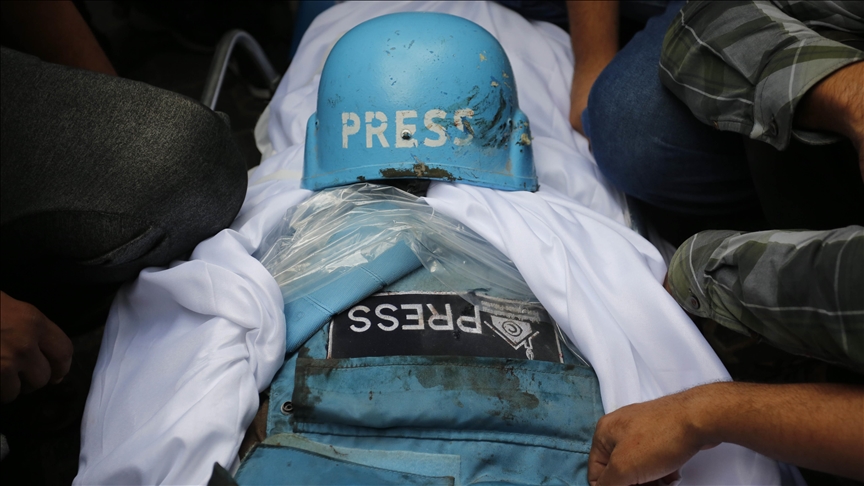A great truth about the ongoing and seemingly unending spiral of violence, death and devastation in Gaza is that truth and those tasked with uncovering truth – journalists – have become one of the worst casualties. It cannot be denied that any war reporter (or correspondent) covering a real conflict zone has voluntarily chosen to be at a high-risk area, which could turn life-threatening at any moment.
In modern-day warfare, it is impossible for any artillery gunner sitting miles away or a jet bomber pilot dropping his lethal payload from thousands of feet above ground to know which individual is sitting in a particular hospital or a housing colony at that moment when the attack takes place. This Gaza war seems the most lethal for the media in recent times. A whole lot of war reporters is being wiped out in a way the media has never witnessed before. To bring to light this unprecedented and brutal suppression of truth, multiple media outlets registered a large-scale protest on 1 September to demand Israel stop the killing of journalists in Gaza and call for the international Press to be allowed into the enclave to report freely.
Nearly 250 outlets from 70 countries took part in the demonstration in forms appropriate to their mode of functioning. Several newspapers ran blacked-out front pages, broadcasters and radio stations interrupted their programming and online outlets disrupted their home pages, stated Reporters Without Borders (RSF), coordinating the protest along with Avaaz and the International Federation of Journalists (IFJ). The objective was to draw global attention to the alarming number of journalists killed during Israel’s war in Gaza.
Also Read: Hope in UK
According to the IFJ, at least 210 journalists have been killed in Gaza since 7 October, 2023. This means the conflict has already become the deadliest for reporters in modern times. The situation has been complicated by the Israeli government’s decision to prevent international media from reporting freely in Gaza, as only Palestinian journalists have been left to fend for themselves while reporting under fire. The Director General of RSF, Thibat Bruttin, painted a gloomy picture of the plight of journalists working in Gaza, fearing that at the rate journalists are dying in Gaza, there will soon be no one left to keep the world informed. Thus, he concluded this is not only a war on Gaza, but “a war on journalism itself.” The civilian death toll in Gaza is already staggering, and journalists too expose themselves to death, while it is important that they remain alive to tell the stories of starvation deaths and famine inflicted on the people of Gaza. The situation, as the protesters put it most succinctly, is such that journalists put their lives at risk to report, while others do so in their bid to escape being hit by missiles and bullets.
The Committee to Protect Journalists (CPJ) has documented the circumstances in which reporters are working in Gaza. It has stated the inescapable conclusion from the volumes of facts and data it has collected that it is the deadliest and most deliberate effort to kill and silence journalists. It is convinced that Palestinian journalists are being threatened, directly targeted and murdered by Israeli forces and are arbitrarily detained and tortured in retaliation for their work.
In fact, journalists in Gaza work in unbearable conditions, fighting against hunger and exhaustion and breaking off reporting to find food for their families, help carry bodies from rubble or assist wounded relatives in finding shelter.
Many are separated from those they love, and many have buried loved ones. But, they carry on undeterred so as to defend the truth. Of course, no one can truly say what the truth is in a situation as seen in Gaza. Among those killed was Anas Al-Sharif, one of the most well-known Palestinian journalists. He became a household name for many in the Arab world due to his daily coverage of the conflict and its humanitarian toll.
Last week, Israel killed another five journalists in back-to-back strikes on the Nasser Hospital in the southern city of Khan Younis. Israeli Prime Minister Benjamin Netanyahu conceded the incident was a “tragic mishap.” Israel usually tries to justify the killings of journalists with the alibi that they were mostly working for Hamas, though it has not been able to provide evidence to buttress its contention. It repeated the same charge against Sharif, too.
The words of the CEO of the CPJ Jodie Ginsberg bear repetition. She said international law is very clear on the point that the only individuals who are legitimate targets during a war are active combatants. Having worked as a media advisor for Hamas, or indeed for Hamas currently, does not make their killings justified, she made it clear. Jodie’s argument, however, is highly untenable in the modern-day style of conducting a war. No one can be identified individually as being of a specific profession from a long-distance bomber cockpit. It may be true that journalists across the globe are fast becoming targets of state-sponsored attacks and harassment for doing their job of uncovering truths and exposing corrupt and oppressive regimes. But the killings in Gaza add a new dimension to the whole issue that needs attention for the future safety of frontline correspondents.
